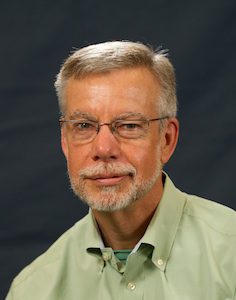
Dr. John Livesey has been a professor at the University of the Pacific in Sacramento, California, for 25 years, teaching future pharmacists and pharmaceutical scientists about endocrine physiology and cancer biology, and conducting research to improve understanding of how to best use pharmaceutical agents to treat human diseases.
Earlier this year, he invited a new partner to join his team: the Opentrons OT-2. We spoke with Dr. Livesey about how his OT-2 pipetting robot is helping reduce students’ anxiety about lab procedures and increase their focus on potentially life-saving work.

Dr. John Livesey. CREDIT: University of the Pacific.
OPENTRONS: Can you please tell us a little more about your research?
DR. JOHN LIVESEY: I look at conditions and drugs that inform epithelial-mesenchymal transition (EMT), a process involved in the metastatic spread of cancer. I do a lot of experiments setting cells into a multiwell plate, feeding the plate, treating the cells with drugs, changing pH and other elements of the environment, and measuring expressions of specific markers in the EMT process using in-cell Western process.
OPENTRONS: What prompted you to bring the OT-2 into your lab?
JOHN: Many students are relatively inexperienced with lab work and have little time to practice, so they are often anxious about being accurate and precise when doing liquid delivery and manipulation. For some, an experiment involves weeks of effort and, if they mess it up, they lose a major part of a semester. They also know we operate on a shoestring budget, and they’re concerned about the cost, especially if they have to throw away an experiment that is off a column or a row on a 96-plate project, or if they inadvertently mixed samples or omitted reagents.
Enter the Opentrons pipetting robot. For a relatively modest investment, I’ve gotten the students to focus on the pharmacology: how to set up treatment, how they’re treating the cells, and how to analyze and interpret the data that comes out of it. There are many steps where the OT-2 can help. It frees them from the actual mechanical manipulation–and the related anxiety.
OPENTRONS: What was it like to get your Opentrons robot up and running?
JOHN: It has been remarkably smooth! It was easy to unbox it, set it up, and run the initial calibration. I bought the OT-2 back in May presuming I would have to learn programming, but my first use of the robot coincided with the public release and open beta testing of the Protocol Designer, almost to the day. The timing couldn’t have been better! I didn’t waste a lot of time learning Python or relying on Opentrons to do the programming.
OPENTRONS: Can you tell us more about how you use the Protocol Designer to program your OT-2 robot?
JOHN: The invention of the Protocol Designer was a godsend. I thought that our use of the OT-2 would mean that we would develop a couple protocols and use them over and over with minor modifications. As it turns out, I have reused protocols occasionally, but we are almost always tweaking them.
The invention of the Protocol Designer was a godsend.
Just yesterday, I was working with an undergraduate research team. The night before, I had spent half an hour working up an entirely new protocol for an experiment they were conducting. Halfway through the first run, I realized I needed to make a change. I went into the protocol and revised it for the second team later that day. The fact that that’s available and fairly easily completed means you can fix your own mistakes relatively quickly. That’s the kind of thing I wouldn’t be doing if I had had to find the step and type in the commands in Python. It makes the OT-2 more flexible and user-friendly.
The fact that the Protocol Designer is available and fairly easily completed means you can fix your own mistakes relatively quickly.
OPENTRONS: What other benefits does the OT-2 offer your students?
JOHN: The OT-2 has certainly sped up how often they conduct experiments, increasing the potential for them to earn authorship of their work. Last year, a research student would have been lucky to finish two or three experiments in a semester. The student may only have three or four hours a week to work, and individual experiments might require many steps over several days or even weeks: that pace of effort will never result in publication—even a mention in the back of a paper.
With the speed of the robot and the productivity that engenders, we’ll be able to put together efforts of multiple student teams to complete perhaps 10 or 15 experiments a semester, and come up with publications in a more reasonable time frame.
The OT-2 is also a great teaching tool. It allows the students to more thoroughly pursue research questions. I typically throw out a question for the students to answer through research, and it’s the rare student who has enough time and focus to come up with a defensible answer. The OT-2 is a valuable way to free them from their pipetting anxiety so they can engage in that kind of higher-level problem-solving.
OPENTRONS: Is there anything else you’d like to share about your Opentrons robot?
JOHN: The whole process is just more engaging. We even named our OT-2; we call it Pinocchio, because if it’s really good maybe it will become a real pharmacologist. Of course, the computer that controls it is Geppetto.
Students really want to work with it, and they are also comfortable with it. During the school year, we have 10 or more undergraduate and doctor of pharmacy students use it almost nonstop—nearly fighting over it—for their research projects. Over the summer, my high school intern designed his own protocols for the individual manipulation of cell treatment. Normally, we would have done that by hand. And now, based on those interactions with the robot, that student wants to be an engineer.
Interview edited for length and clarity.